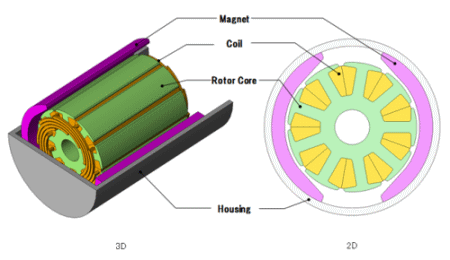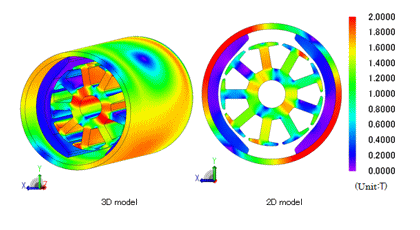Contents
1. Introduction
2. Comparing 2D/3D Models and Evaluating Corrections
2-1. Comparing 2D/3D models
2-2. Comparing 2D/3D models accounting for housing geometry
2-3. Comparing 2D/3D models accounting for housing/magnet geometry
3. Summary
1. Introduction
As brush motors are cost efficient and do not require control circuits, these familiar DC motors are used in a wide range of applications, from toys to industrial products.
Though brush motors have a relatively simple operating mechanism, performing an analysis on them is difficult, and the following items pose challenges.
- Since current flows by mechanical contact between a brush and a commutator, the model must take this brush-commutator contact into account.
- The axis length of the rotor core, magnet, and housing are all different, so magnetic flux in the axial direction cannot be ignored.
- Because the housing is thin, magnetic saturation has a large effect, leading to an increase in magnetic flux in the axial direction.
In this applied case, the structure of a 2D analysis model accounting for 3D geometry is evaluated through the comparison with a 3D analysis model. The modeling validity is proved by comparing these results.
Key Technology
- Brush motor element
Current flows by mechanical contact between a brush and a commutator in a physical brush motor. With JMAG, an analysis can be performed by using the brush motor element, a component specialized for brush motor analyses, which expresses the positional relation of the brush and commutator on an electric circuit. - Material Modeling
The JMAG material modeling function provides various modeling methods, such as specifying steel sheet lamination factor based on the homogenization method and specifying anisotropic magnetization characteristics / anisotropic electric characteristics. Also for magnetization characteristics, steel sheet magnetic saturation characteristics and magnet coercive force characteristics can be specified as parameters. In this study, we use the percentage of the housing and magnet in the magnetic circuit of 3D geometry as a parameter for the magnetic characteristics of a 2D model. This allows an analysis of a 2D model accounting for 3D geometry.
2. Comparing 2D/3D Models and Evaluating Corrections
2-1. Comparing 2D/3D models
To confirm the effects of 3D geometry, the results of 2D and 3D models (Fig.1) are compared using the same magnetic properties. From the comparison of magnetic flux density distribution shown in fig. 2, magnetic saturation in the housing is notable especially in the 2D model. On the contrary, saturation can be seen in the 3D model but less than the 2D model, and distribution in the axis direction can be observed.

Fig.1 Structure of the analysis model and its parts

Fig. 2 Magnetic flux density distributions of 2D/3D models
You need to sign in as a Regular JMAG Software User (paid user) or JMAG WEB MEMBER (free membership).
By registering as a JMAG WEB MEMBER, you can browse technical materials and other member-only contents for free.
If you are not registered, click the “Create an Account” button.
Create an Account Sign in



